NUCLEAR SERVICES
The importance of radiation protection in proton therapy facilities
Proton therapy is an advanced radiotherapy technique that uses protons to precisely and effectively treat tumours. However, to ensure this treatment is performed safely, rigorous radiation protection measures must be implemented. In this article, we explain how proton therapy facilities operate and how our team works to ensure that they always meet the highest safety standards, protecting both patients and medical staff.
How it works
Conventional external beam radiotherapy techniques typically use linear accelerators (linacs), which produce electron beams or X-rays (photons). The latter are the most commonly used. Proton therapy, a type of external radiation therapy, uses a beam of protons to irradiate the tumour. Protons are notable for their characteristic dose distribution, known as the Bragg curve, which has a peak dose at the end of its path, after which the dose decreases dramatically. This enables a maximum dose to be delivered to the tumour while minimising exposure to adjacent critical healthy organs.
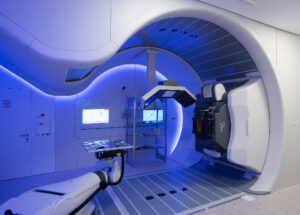
Gantry head in a proton therapy room. Photo © Jorge Allende
In a conventional proton therapy system, patients only see the tip of the iceberg in the treatment room: the gantry head. Most of the equipment is hidden behind this, in adjacent rooms. The entire system consists of three main parts:
- The gantry structure is the rotating beamline that transports the beam from the accelerator room to the treatment room while maintaining the correct parameters.
- A proton beam of up to 230 MeV is generated and extracted by the accelerator.
- The fixed beamline is equipped with an energy selection system, which transports the beam with the correct energy and parameters to the gantry.
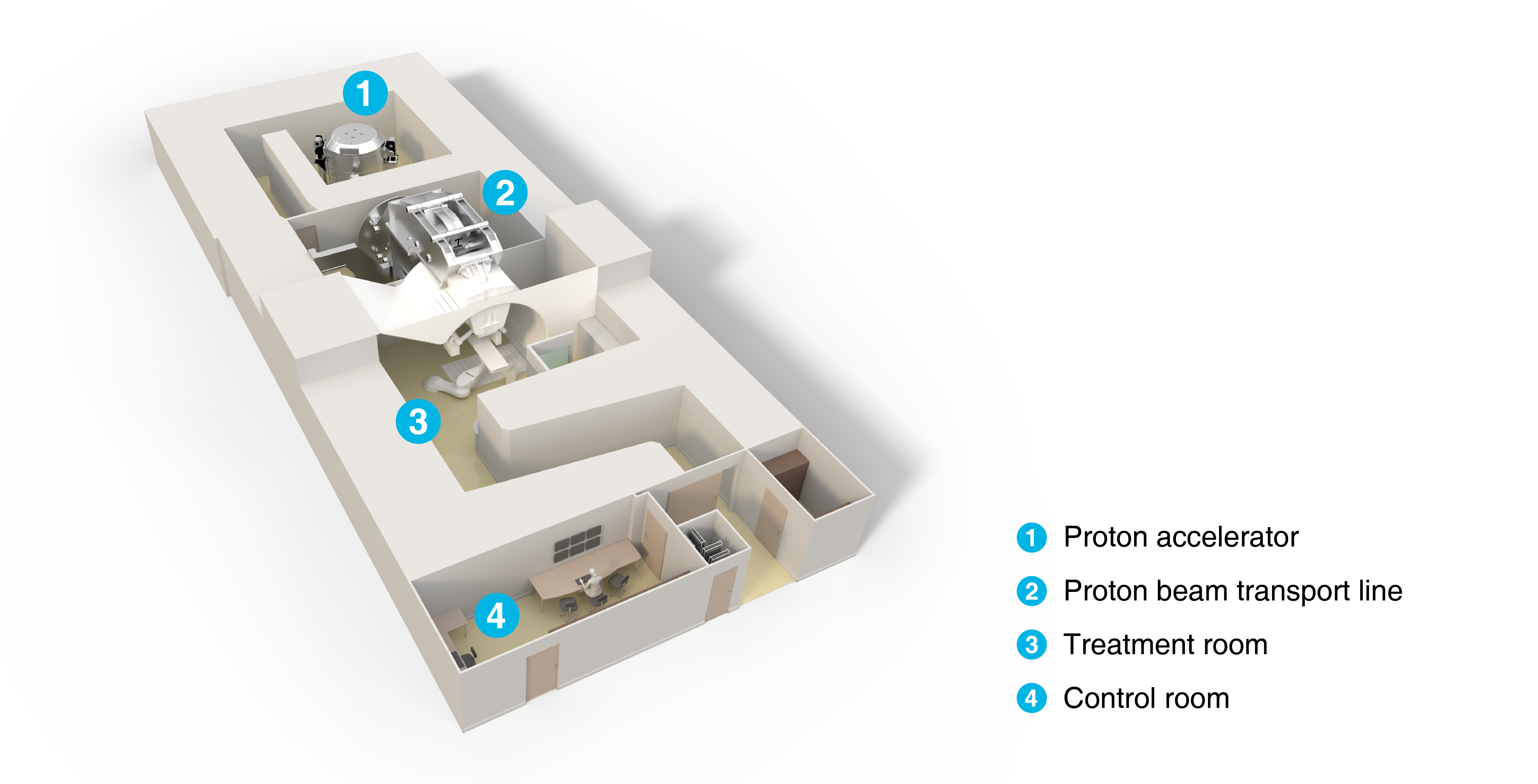
Main parts of the IBA ProteusOne proton therapy equipment on a gantry. Image © IBA Particle Therapy

To ensure that proton therapy treatment is carried out safely, it is crucial to implement rigorous radiation protection measures
How radiological activation occurs
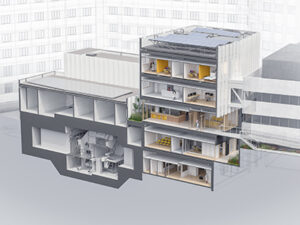
Section of the Proton Therapy Unit at La Paz University Hospital in Madrid
During irradiation, the accelerator generates high secondary neutron and photon dose rates, so it must be located in a bunker with appropriate thicknesses of shielding (up to approximately 3 metres of standard concrete). Additionally, the interaction of protons and neutrons in the accelerator and beamline devices activates the components, converting them into radioactive sources of gamma and beta rays. The intensity of these rays depends on the characteristics of the beam, the irradiation and the material, and they decay gradually over time after irradiation. Appropriate radiation protection measures must therefore be taken during team maintenance, as well as proper project management of the replaced components.
The same activation phenomenon occurs with the air in the bunker rooms due to the interaction of neutrons with the elements in the air, as well as with the water in the cooling systems of the equipment. Over time, the structural shielding (concrete walls and reinforcing bars) also becomes activated, generating long-lived isotopes depending on its composition and the radiation load throughout the facility’s lifetime. Therefore, decommissioning requires a closure plan that considers the management of the radioactive waste generated during this stage.
Radiation protection measures to be implemented
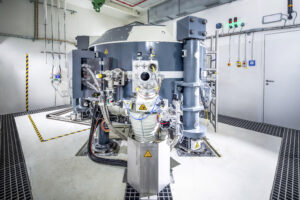
Proton accelerator. Photo © IBA Particle Therapy
The main risk associated with this type of facility is external radiation. To a much lesser extent, there is also the risk of external and internal contamination due to the activation of water, air, dust, oils, etc.
Therefore, this equipment presents radiation protection issues that are more typical of a nuclear facility than a conventional medical facility. In order for the facility to operate safely while taking into account the radiation risks, several measures must be taken in addition to shielding. These include appropriately classifying and signage for rooms, access control and security systems (e.g., door and beam interlocks, search systems*, emergency stop buttons, and cameras), and other systems that play an important role in safety, such as the ventilation system and fixed radiation measurement probes. These auxiliary systems and others, such as the electrical and cooling systems, are located in technical rooms that are usually situated above or around the bunker. Two important rooms for operating the facility are the control room, where the team’s operations are managed, and the storage room for radioactive waste and activated material. This room also requires structural shielding.
Proper design is only one aspect of ensuring the safety of an installation. Other equally important aspects include organization, operating procedures, a maintenance plan, a plan for equipment calibration and verification, and an internal emergency plan.
All of this results in workers typically receiving low doses, which are much lower than those in other medical fields, such as nuclear medicine and interventional radiology.
Facility licensing
In Spain, these types of facilities are classified as Category 2 radioactive and are subject to applicable radiation protection regulations. This means that owners must apply for an operating license, which is reviewed by the Nuclear Safety Council (CSN), before they can begin operations. The application for authorization (licensing) must include a significant number of documents and studies, including a descriptive report, a safety study, operating regulations, and an internal emergency plan.
Designing, commissioning, and operating these facilities is complex and requires multiple technical disciplines. IDOM has solid capabilities and experience in designing and providing licensing support for this type of facility. Notably, IDOM can offer architecture, conventional engineering, and nuclear engineering services together, providing an adequate response to this type of project. IDOM has already participated in five of these projects. (QuirónSalud Proton Therapy Unit in Madrid, the Kutaisi International University Research and Treatment Center in Georgia, the Proton Therapy Center for Osakidetza in San Sebastián, the Marqués de Valdecilla Hospital Proton Therapy Unit in Santander, and the Proton Therapy Unit at La Paz University Hospital in Madrid). Three of these projects included nuclear services (QuirónSalud, Osakidetza, and La Paz).
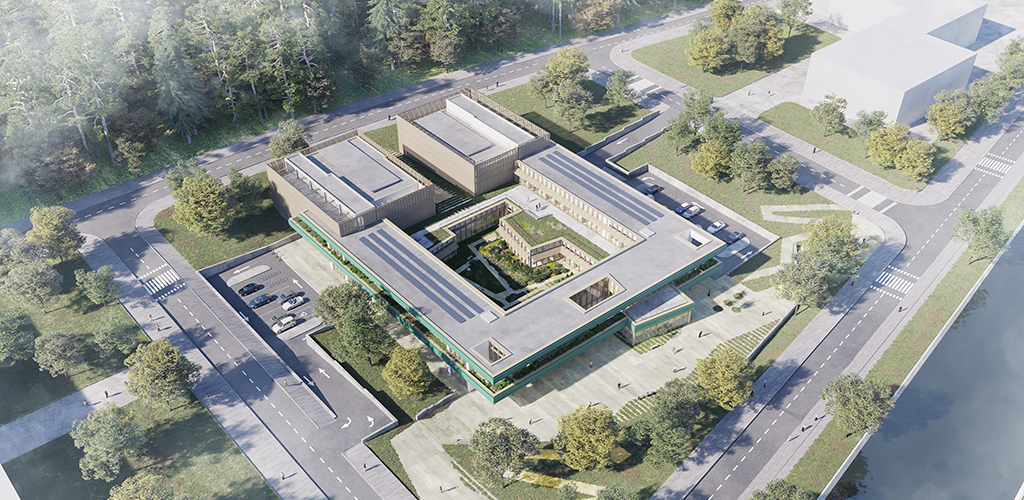
Aerial view of the Kutaisi International University Research and Treatment Center in Georgia
The future of radiation therapy
Radiotherapy is evolving rapidly, giving rise to advanced new treatments that use neutrons and other charged heavy particles. These treatments require new teams and facilities. There is also the possibility of a future change in dose fractionation patterns toward the flash technique, which would require very high dose rates for treatments lasting only a few seconds. IDOM is prepared to address the technological challenges of future radiotherapy.
* The search system sequentially activates one or more area and contact search buttons to ensure that no one is present before irradiation. The buttons are designed so that the last person to leave the room must perform an inspection round. They start with the areas farthest from the exit and check corners where someone might not be easily visible. The room is considered secure once the entire search sequence has been completed correctly. The security system will not allow irradiation if the room is not secure.



